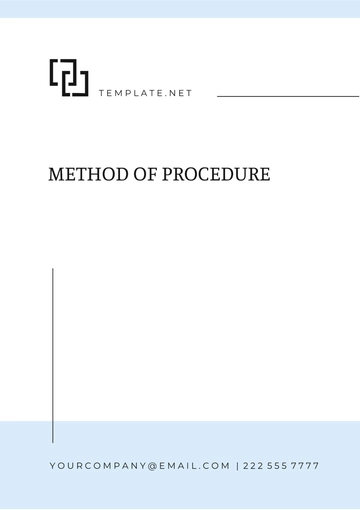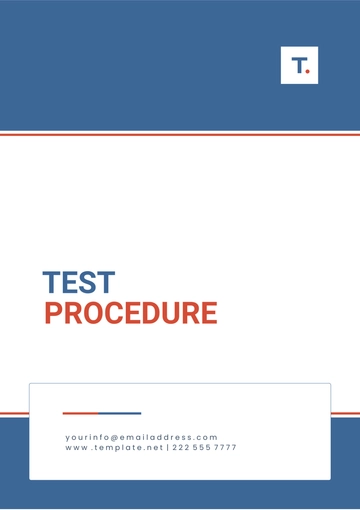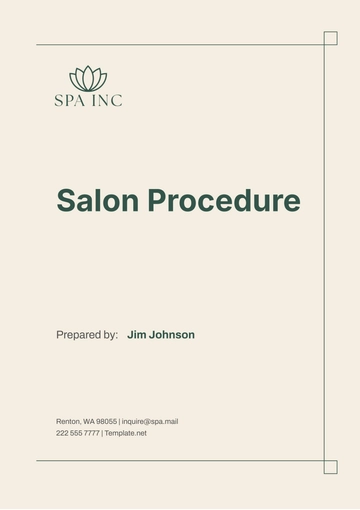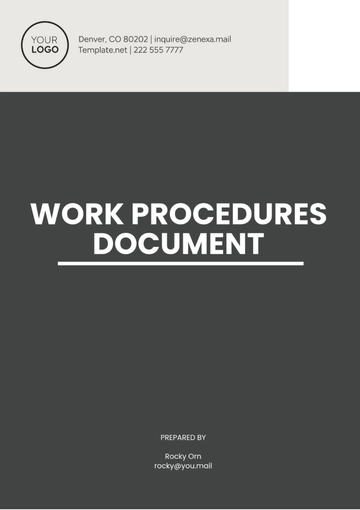Free Law Firm Client Engagement Procedure

I. Introduction
Overview of the Client Engagement Procedure
The Client Engagement Procedure serves as a comprehensive guide for [Your Company Name] in managing client relationships effectively. It outlines the firm's commitment to professionalism, integrity, and client-centered service. By adhering to this procedure, the firm ensures consistency and quality across all client engagements, regardless of practice area or legal matter.
Purpose and Objectives
The primary purpose of the Client Engagement Procedure is to establish clear guidelines for client interactions that prioritize ethical conduct, legal compliance, and client satisfaction. The objectives include streamlining administrative processes, mitigating risks associated with client representation, and fostering long-term client relationships built on trust and transparency.
Applicability and Scope
This procedure applies to all attorneys, paralegals, administrative staff, and other personnel involved in client representation at [Your Company Name]. It encompasses all stages of the client engagement lifecycle, from the initial consultation to the conclusion of legal matters. The procedure is applicable to clients across various industries and practice areas served by the firm.
II. Initial Consultation
Scheduling and Preparation
Upon receiving a request for consultation, the receptionist or intake coordinator promptly schedules an appointment using the firm's scheduling system. The attorney assigned to the consultation reviews any available information provided by the client, conducts preliminary research on the legal issue, and prepares relevant materials or questions to facilitate a productive discussion.
Client Intake Form
Field | Description |
|---|---|
Personal Details | Name, date of birth, occupation, marital status, and any other relevant demographic information. |
Contact Information | Address, phone number, email address, and preferred method of communication. |
Legal Issue Details | Brief description of the legal issue or matter requiring legal assistance. |
Identification Documents | Type of identification provided (e.g., driver's license, passport) and document number. |
Conflicts Check Process
Following the consultation, the attorney conducts a conflicts check using the firm's conflicts management system. This involves searching the firm's database for any existing or potential conflicts of interest that could impair the attorney's ability to represent the client effectively. If conflicts are identified, the matter is escalated to firm management for resolution or referral to another attorney within the firm.
III. Engagement Letter
Purpose and Contents
The Engagement Letter serves as a formal agreement between [Your Company Name] and the client, outlining the terms and conditions of the attorney-client relationship. It includes details such as the scope of legal services to be provided, the attorney's responsibilities, the client's obligations, fee arrangements, billing procedures, and any limitations on the representation. Additionally, the letter may contain disclaimers regarding the outcomes of legal matters and potential conflicts of interest.
Drafting and Review Process
The attorney responsible for the client's matter drafts the Engagement Letter based on the information gathered during the initial consultation and in consultation with firm management, if necessary. The draft is reviewed by a supervising attorney or partner to ensure accuracy, clarity, and compliance with firm policies, ethical rules, and applicable laws. Any revisions or modifications are made before finalizing the letter for execution.
Execution and Delivery to Client
Once approved, the Engagement Letter is executed by both the client and [Your Company Name]. The attorney ensures that the client understands the terms of the engagement and addresses any questions or concerns they may have before signing. A copy of the signed letter is provided to the client for their records, and the original is securely retained in the client's file within the firm's document management system.
IV. Client Intake Process
Information Collection
Administrative staff responsible for client intake collect and record the client's information accurately and completely in the firm's case management system. This includes verifying the spelling of the client's name, confirming contact details, and documenting any special instructions or preferences provided by the client. Information is entered promptly to avoid delays in processing and to ensure the client's needs are addressed efficiently.
Client Identification and Verification
In compliance with anti-money laundering (AML) and know-your-customer (KYC) regulations, [Your Company Name] verifies the identity of the client using government-issued identification documents. This process helps mitigate the risk of fraud, ensures the integrity of client relationships, and demonstrates the firm's commitment to ethical and regulatory compliance. Identification documents are securely stored in the client's file, accessible only to authorized personnel.
Document Management and Retention
All documents obtained during the client intake process are securely stored in the client's electronic file within the firm's document management system. Administrative staff assign appropriate tags or labels to documents for easy retrieval and categorization. Documents are retained in accordance with the firm's retention policies, which may vary depending on the nature of the legal matter and applicable legal requirements.
V. Communication Channels
Preferred Modes of Communication
Clients are encouraged to communicate with their assigned attorney through their preferred method, including email, phone calls, or in-person meetings. The firm's communication policy ensures timely responses to client inquiries and requests, with attorneys aiming to acknowledge receipt of client communications within 24 hours.
Response Time Expectations
Attorneys strive to respond to client communications promptly, typically within one to two business days, unless circumstances require a more immediate response. In urgent situations, clients are provided with alternative contact information for emergency assistance outside of regular business hours.
Emergency Contact Procedures
In the event of an emergency or urgent legal matter, clients can reach [Your Company Name]'s emergency contact line, which is monitored by designated personnel. Attorneys are notified promptly of any urgent client needs, and appropriate action is taken to address the situation in a timely manner.
VI. Confidentiality and Privacy
Client Confidentiality Policy
[Your Company Name] maintains strict confidentiality regarding all client information and communications, in accordance with legal and ethical obligations. Attorneys and staff are required to uphold client confidentiality at all times, and access to client files is restricted to authorized personnel only.
Handling of Sensitive Information
Sensitive information provided by clients is handled with the utmost care and discretion. All electronic and physical documents containing sensitive information are stored securely, with access limited to individuals directly involved in the client's representation.
Data Security Measures
[Your Company Name] employs robust data security measures to protect client information from unauthorized access, disclosure, or loss. This includes encryption of electronic communications, secure password protection for digital files, and regular monitoring of IT systems for potential security breaches.
VII. Billing and Payment Arrangements
Billing Rates and Fee Structures
The firm's billing rates and fee structures are outlined in the Engagement Letter and discussed with the client during the initial consultation. Rates may vary depending on the attorney's level of experience, the complexity of the legal matter, and the prevailing market rates for similar services.
Retainer Requirements
Depending on the nature of the legal matter, clients may be required to provide a retainer or advance payment to cover anticipated legal fees and expenses. The amount of the retainer is determined based on an estimate of the work required and is held in trust until billed for services rendered.
Payment Methods and Terms
Clients have the option to pay legal fees and expenses by various methods, including credit card, bank transfer, or check. Invoices are issued periodically, detailing the services provided and the corresponding charges. Payment terms are typically within 30 days of the invoice date, unless otherwise agreed upon in writing.
VIII. Legal Representation
Assignment of Legal Team
Upon execution of the Engagement Letter, [Your Company Name] assigns a dedicated legal team to the client's matter, consisting of attorneys and support staff with relevant expertise and experience. The client is informed of their primary point of contact within the firm and provided with contact information for all team members involved in their representation.
Scope of Legal Services
The Engagement Letter defines the scope of legal services to be provided, outlining specific tasks, objectives, and deliverables. This may include legal research, drafting of documents, negotiation with opposing parties, representation in court proceedings, and other related activities necessary to achieve the client's objectives.
Responsibilities of Client and Firm
Both the client and [Your Company Name] have defined responsibilities outlined in the Engagement Letter. The client is responsible for providing accurate information, timely responses to requests for information or documents, and payment of legal fees and expenses as agreed upon. The firm is responsible for diligently representing the client's interests, maintaining communication, and providing competent legal advice and representation.
IX. Case Management
Case File Organization
A dedicated electronic case file is created for each client matter within the firm's case management system. Documents, correspondence, and other relevant information are organized systematically within the file, allowing for easy access and retrieval by authorized personnel.
Deadlines and Milestones
Key deadlines and milestones pertaining to the client's matter are identified and tracked diligently by the legal team. This includes court-imposed deadlines, statute of limitations, discovery deadlines, and other critical dates relevant to the progress of the case.
Regular Case Reviews and Updates
The legal team conducts regular reviews of the client's matter to assess progress, identify any emerging issues or challenges, and adjust strategies as necessary. Clients are provided with periodic updates on the status of their case, including significant developments, milestones achieved, and next steps.
X. Dispute Resolution Procedures
Client Grievance Process
[Your Company Name] has established a client grievance process to address any concerns or complaints raised by clients regarding the firm's services or conduct. Clients are encouraged to communicate their grievances directly to their attorney or designated firm contact, who will promptly investigate the matter and work towards a resolution.
Conflict Resolution Mechanisms
In the event of conflicts or disagreements between the client and the firm, [Your Company Name] is committed to resolving such issues in a fair and amicable manner. This may involve mediation, arbitration, or other alternative dispute resolution methods, as agreed upon by both parties.
Escalation Procedures
If a satisfactory resolution cannot be reached through informal means, clients have the option to escalate their concerns to firm management or designated partners for further review and resolution. [Your Company Name] is dedicated to addressing client concerns promptly and ensuring that clients receive the highest quality of service and representation.
XI. Closing the Engagement
Completion of Legal Services
Upon successful resolution of the client's legal matter or fulfillment of the agreed-upon scope of services, [Your Company Name] notifies the client that the engagement is nearing completion. Any outstanding tasks or obligations are addressed, and the client is informed of the final steps to conclude the representation.
Final Billing and Invoicing
A final invoice detailing all fees and expenses incurred throughout the representation is prepared and sent to the client for review and payment. The invoice includes a breakdown of services rendered, time spent, and any additional costs, along with instructions for payment and applicable due dates.
Document Disposition and Return
All original documents provided by the client or generated during the representation are returned to the client upon request or as agreed upon in the Engagement Letter. Copies of relevant documents are retained in the client's file for recordkeeping purposes, in compliance with retention policies and legal requirements.
XII. Feedback and Follow-up
Client Satisfaction Surveys
Following the conclusion of the engagement, clients are invited to participate in a confidential satisfaction survey to provide feedback on their experience with [Your Company Name]. Feedback is collected anonymously and used to evaluate the firm's performance, identify areas for improvement, and enhance client service delivery.
Post-Engagement Review Meetings
In some cases, attorneys may schedule post-engagement review meetings with clients to discuss the outcome of the representation, address any remaining questions or concerns, and solicit feedback on the firm's performance. These meetings provide an opportunity for open dialogue and strengthen the client relationship.
Continuous Improvement Initiatives
Feedback received from client satisfaction surveys and post-engagement review meetings is analyzed by firm management to identify trends, patterns, and opportunities for improvement. [Your Company Name] is committed to implementing changes and initiatives aimed at enhancing client satisfaction, improving service delivery, and maintaining high standards of excellence.
XIII. Compliance and Regulatory Considerations
Legal and Ethical Compliance
[Your Company Name] is committed to upholding the highest standards of legal and ethical conduct in all client engagements. Attorneys and staff are required to comply with applicable laws, rules of professional conduct, and ethical guidelines governing the legal profession.
Regulatory Reporting Requirements
The firm maintains compliance with regulatory reporting requirements imposed by relevant governing bodies, including bar associations, licensing authorities, and regulatory agencies. This includes timely submission of required reports, disclosures, and certifications as mandated by applicable regulations.
Monitoring and Audit Procedures
Internal monitoring and audit procedures are implemented to ensure ongoing compliance with legal, ethical, and regulatory requirements. This includes periodic reviews of firm policies and procedures, training programs for attorneys and staff, and internal audits to assess adherence to established standards and identify areas for improvement.
- 100% Customizable, free editor
- Access 1 Million+ Templates, photo’s & graphics
- Download or share as a template
- Click and replace photos, graphics, text, backgrounds
- Resize, crop, AI write & more
- Access advanced editor
Secure your law firm's client engagements with our customizable template from Template.net. This editable Law Firm Client Engagement Procedure Template offers a comprehensive framework for managing client relationships. Tailor it to your firm's specific needs using our AI Editor Tool. Ensure clarity, transparency, and efficiency in client interactions with this essential resource.





























